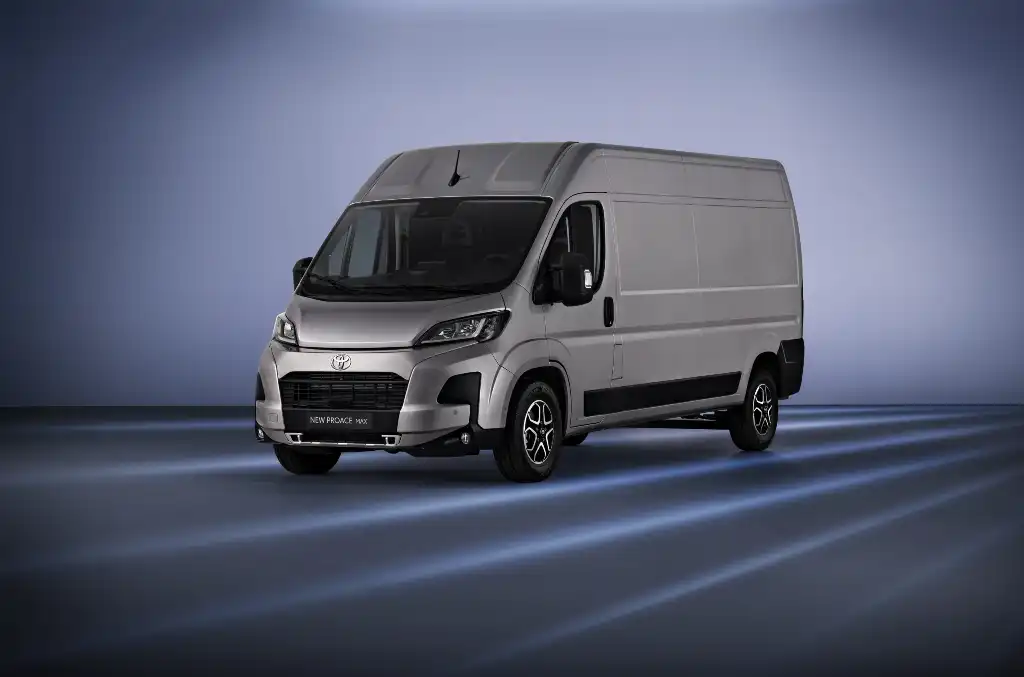
Last year we saw Toyota announce its intentions to divert energy away from hydrogen in passenger cars and into commercial vehicles. This was followed up with details of a hydrogen-powered pick-up trial being led by Toyota GB. Yet Toyota isn’t abandoning other powertrains, far from it, as they have now completed their LCV range with the addition of the Proace Max large van to its line-up. Now with full coverage of ICE and BEV versions, Toyota not only has a full range of panel vans with combustion and zero-emission options but arguably also possesses the most complete line-up of any manufacturer when you add the Corolla Commercial and Land Cruiser Commercial, not to mention Hilux, into the mix. Didier Gambart, president of KINTO Europe, Toyota’s ride sharing business, and formerly vice president of Toyota Europe at the time of our meeting, explained that Toyota sees itself as a hydrogen pioneer in much the same way as it championed hybrids with the Prius.
The new Proace Max is available in a wide range of dimensions so customers can choose a size that’s best for their needs. Specialist requirements can be addressed with a wide range of conversion possibilities.
In the UK, four different sizes are available in full van format, based on two wheelbase options (3,450 and 4,035mm), three different lengths (5,413, 5,998 and 6,363mm) and two heights (2,524 and 2,764mm). These combinations offer spacious cargo area volume from 11 to 17m³, space enough to comfortably hold five Euro pallets.
In addition to the full van offerings, Proace Max is an adaptable companion for specialised tasks. It is available in factory-built one-way tipper and dropside configurations, and in Crew Cab form with a second row of four seats to increase seating capacity to seven.
Vehicle weights are 3,500kg for the diesel and 4,250kg for the battery electric models. All variants have impressive load-carrying and towing capacities. The battery electric Proace Max leads its class with 1,800kg payload capacity and 2,000kg towing capability, depending on the model size configuration. With diesel vehicles, payloads of up to 2,270kg can be carried; maximum towing capacity is 3,000kg (depending on the combination of length and height).
Loading and unloading is straightforward thanks to full height doors and a practical square opening, 1,562mm wide and up to 2,030 mm high, with a low threshold. UK models are fitted with double sliding side doors, maximising loading convenience.
“We see the future of hydrogen for the LCV,” he told Van Reviewer at the annual Kenshiki Forum. “When it comes to the hydrogen, it would be strange that Toyota will not take a leading role considering our pioneering position. We don't see the future without an H2 solution. How, and with whom, is something that we cannot disclose because we are in the thinking and discussion process, but for sure the hydrogen solution would make a lot of sense in terms of payload and in terms of towing capacity.”
Gambart also points out that hydrogen meets the needs of rapid refuelling and range that EVs have yet to establish their credentials in. The Hilux H2 pilot is an example of an obvious use-case by a customer in the UK that has a hydrogen refuelling infrastructure and a desire to decarbonise its commercial vehicles, without compromising on their use. Gambart insists there’s more to come from the trial and that “production at scale” of the hydrogen Hilux is hopefully where the project ends up. However, he is quick to reassert that the development of such products also requires support.
“We need a by market approach,” he says, explaining that hydrogen products will eventually be available to countries that have developed their infrastructure. “We know that [the president of France] Macron, wants to develop the hydrogen, and they put a lot of resources for that. There are also two domestic players that are very much interested, Stellantis and Renault are developing their own hydrogen technology. So, we can assume that France should become a more mature market in the near future when it comes to the hydrogen infrastructure. That's why it's a ‘by market approach’ and this is something we are following very closely.
He adds: “The golden question remains, the development of the infrastructure, and that, of course, we don't control on our own. We see some competitors moving into that direction as well, so there is recognition from all OEMs that hydrogen should be a suitable powertrain and technology for the future,” Gambart explained.
His reference to competitors is an interesting one as he is referring to Stellantis’ own activity in the mid-sized van segment with a hydrogen-powered Vauxhall Vivaro. It comes as no coincidence that Gambart identifies the Stellantis ProOne brands as the competition, given Toyota’s own reliance on their products for their LCV range. Toyota plans to increase its share of the van market and sees the Stellantis models as their main and most obvious competition. However, for hydrogen power it’s not clear if Toyota would be looking to venture alone in the market and points back to their current relationship with Stellantis on their LCV range as an example of where the combined strength of partnerships helps everyone.